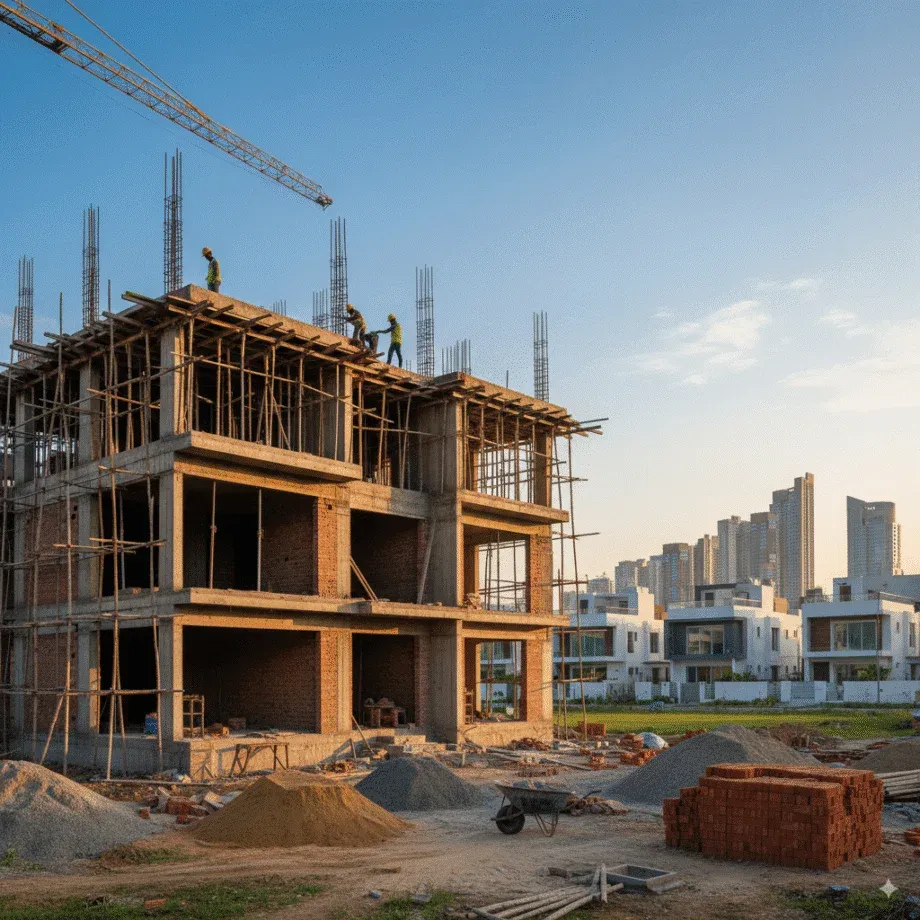Rapid urbanization, population growth, and climate challenges are worldwide among the major issues. As a result, Governments and developers are driven to change their approach. They are compelled to rethink how cities are built and managed.
The very concept of Building Infrastructure has changed. It is no longer confined to just utility lines, roads and bridges. It also includes smart technologies and data-driven planning. Along with sustainable engineering practices, they are making modern cities more livable.
BUILDING INFRASTRUCTURE
Modern building infrastructure is often misinterpreted. Hence, it’s important to know what Building Infrastructure is.
It traditionally was referred as the foundational systems that support the functioning of the city. This included transportation networks, water supply, sanitation, electricity distribution, and other core structures.
Today, the term has graduated to include:
- Smart building systems.
- Digital connectivity & IoT networks.
- Waste management. Also, recycling technologies.
- Intelligent mobility and traffic systems.
- Resilient urban planning for climate adaptation.
- Sustainable power systems. Like wind, solar, and hybrid.
Modern building infrastructure in short comprise of every aspect that improves the way people live, work, and interact within a city.
HOW INNVOATION IS RESHAPING CONSTRUCTION BUILDING INFRASTRUCTURE?
Here’s how innovation is reshaping construction building infrastructure.
SMART CONSTRUCTION TECHNOLOGIES
BUILDING INFORMATION MODELING (BIM)
It allows between architects, engineers, and contractors, digital visualization and real-time collaboration.
Additionally, it helps improve:
- Project timelines.
- Cost estimation.
- Planning accuracy.
- Clash detection.
Every advanced building contractor engaged in large-scale infrastructure projects relies for fast and error-free execution, on BIM
DRONES IN CONSTRUCTION
Drones are today used for:
- Surveying land;
- Mapping project progress; and
- Inspecting risk-prone areas.
They
- Reduce manual labor.
- Improve accuracy.
- Enhance safety.
ROBOTICS AND AUTOMATION
Robotic bricklayers, 3D printing machines, and automated cranes are being used increasingly.
These innovations help
- Speed-up construction; and
- Reduce human errors.
SMART MOBILITY & TRANSPORTATION INFRASTRUCTURE
Cities worldwide are increasingly veering toward intelligent mobility solutions. They minimize traffic congestion and carbon emissions.
INTELLIGENT TRAFFIC MANAGEMENT SYSTEMS:
Include AI-controlled signals; vehicle tracking; and live-traffic monitoring. They help
- Reduce traffic congestion,
- Improve efficiency of public transport.
ELECTRIC VEHICLE (EV) INFRASTRUCTURE:
Involve as part of modern infrastructure planning,
- EV-ready roads;
- Integrated parking systems; and
- Charging stations.
RAPID TRANSITY & METRO SYSTEMS:
Smart metro rail networks with automated operations in top Indian cities like Bangalore, Hyderabad, Delhi, etc, have
- Become a central part of modern building infrastructure. They help support public mobility.
- Helped enhance mobility.
SUSTAINABLE & GREEN BUILDING INFRASTRUCTURE
Environmental sustainability no longer is an optional.It has become an obligation for a cleaner and safer world.Green house innovations are rapidly altering worldwide cities’ landscapes.
ENERGY-EFFICIENT BUILDINGS:
- Include Smart HVAC systems and automation lighting controls
- Include insulated materials and solar rooftops.
- Minimize consumption of energy.
SMART WATER MANAGEMENT:
- Include IoT-enabled meters.
- Include leak detection systems.
- Ensure efficient water usage. This helps prevent waste of water.
RENEWABLE ENERGY INTEGRATION: Cities the world over are adopting:
- Solar Farms.
- Wind Energy.
- Waste-to-energy plants.
The above green technologies are now for modern urban planning standard requirements.
DIGITAL CONNECTIVITY & IoT-POWERED INFRASTRUCTURE:
Modern cities for efficient public services management rely heavily on digital networks.
SMART GRIDS: AI-powered electricity grids
- Allow dynamic load distribution.
- Reduce blackouts and energy waste.
IoT SENSORS: Track,
- Air quality;
- Traffic flow;
- Building energy usage; and
- Waste disposal.
The gathered data help governments make real-time decisions that improve city services.
PUBLIC WI-FI NETWORKS: Connectivity has become in smart cities a fundamental part of Building Infrastructure. Free Wi-Fi services help
- Enhance accessibility; and
- Support digital transformation.
MODULAR & PRE-FABRICATED INFRASTRUCTURE
Among the biggest revolutions in Construction Building Infrastructure, these structures are built off-site in controlled factories. Then, later they are assembled on-site. They provide huge benefits like:
- Faster construction;
- Higher quality control;
- Reduced material wastage;Lower cost fluctuations; and
- Minimal weather-related delays.
Modular technology is now used to:
- Affordable housing systems;
- Schools and hospitals;
- Offices and commercial buildings; and
- Metro stations and public utility rooms.
Modern building contractors increasingly adopt modular solutions.
They help
- Speed-up delivery.
- Reduce traditional on-site methods dependence.
SMART PUBLIC INFRASTRUCTURE
Smarter infrastructure comprise of civic amenities. They help enhance everyday living.
SMART STREET LIGHTING:
- Involve LED lights with motion sensors.
- Reduce use of energy.
INTELLIGENT WASTE MANAGEMENT:
- Involve IoT dustbins. They send alerts when full.
- Help improve efficient waste collection.
SMART PARKING SYSTEMS:
- Involve Digital parking sensors and apps.
- Help reduce congestion. This in turn helps to save on fuel.
E-GOVERNANCE:
- Involve Digital service centers, online citizen apps, and automated grievance systems.
- Help improve public convenience and government efficiency.
RESILIENT INFRASTRUCTURE & CLIMATE ADAPTATION
Climate change has forcing cities to rethink how infrastructure is built.
FLOOD-RESISTANT STRUCTURES:
- Include elevated roads and raised embankments. Also, smart drainage systems.
- Help manage heavy rainfall.
HEAT-RESISTANT MATERIALS:
- Cities in high-temperature zones use reflective roofs and heat-resistant concrete. They help increase absorption of heat.
SMART MONITORING SYSTEMS:
- Involve sensors. They monitor weather conditions.
Help send early alerts for floods, landslides, or storms. Smart resilience planning
- Protects several lives.
- Reduce post-disaster losses.
CONCLUSION
Innovation is reshaping worldwide how cities are built and managed. This brings to fore the question – What building infrastructure is today? It means understanding the role of technology, smart design, and sustainability in shaping modern living spaces.
Every aspect of construction building infrastructure from BIM to smart mobility, BIM, and more, is evolving at a rapid pace. Adopting these innovations with leading building contractor Thikedaar’s assistance will help developers drive the transformation of urban infrastructure.



